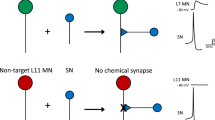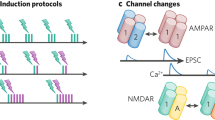Abstract
Synaptic plasticity is an important feature of neural networks involved in the encoding of information. In the analysis of long-term potentiation and long-term depression, several examples have emerged in which this plasticity is itself modulated1,2,3. This higher-order form of plasticity has been referred to as ‘metaplasticity’4, a modification of synapses reflected as a change in the ability to induce or maintain plasticity. These observations raise the question of the possible advantage of regulating the intrinsic plastic properties of a synapse. The neural circuit mediating the siphon withdrawal reflex in Aplysia provides a useful network in which to examine this question directly. Inhibitory synapses in this circuit (from L30 neurons) exhibit a variety of forms of activity-dependent short-term synaptic enhancement which contribute to dynamic gain control in the siphon withdrawal reflex5,6,7,8,9. Here we report that tail shock, an extrinsic modulatory input of known behavioural relevance, induces differential metaplasticity at this synapse, attenuating its ability to exhibit short-term synaptic enhancement after presynaptic activation (augmentation and post-tetanic potentiation), while leaving intact its capacity for enhancement during activation. This attenuation of inhibition at the synaptic level seems to mediate comparable attenuation of inhibitory modulation at both network and behavioural levels.
This is a preview of subscription content, access via your institution
Access options
Subscribe to this journal
Receive 51 print issues and online access
$199.00 per year
only $3.90 per issue
Buy this article
- Purchase on Springer Link
- Instant access to full article PDF
Prices may be subject to local taxes which are calculated during checkout





Similar content being viewed by others
References
Kirkwood, A., Rioult, M. G. & Bear, M. F. Experience-dependent modification of synaptic plasticity in visual cortex. Nature 381, 526–528 (1996).
Demendonca, A. & Ribeiro, J. A. Adenosine and neuronal plasticity. Life Sci. 60, 245–251 (1996).
Kaneko, S., Maeda, T. & Satoh, M. Cognitive enhancers and hippocampal long-term potentiation in vitro. Behav. Brain Res. 83, 45–49 (1997).
Abraham, W. C. & Bear, M. F. Metaplasticity: the plasticity of synaptic plasticity. Trends Neurosci. 19, 126–130 (1996).
Fischer, T. M. & Carew, T. J. Activity dependent recurrent inhibition: A mechanism for dynamic gain control in the siphon withdrawal reflex of Aplysia. J. Neurosci. 13, 1302–1314 (1993).
Fischer, T. M. & Carew, T. J. Cutaneous activation of the inhibitory L30 interneurons provides a mechanism for regulating adaptive gain control in the siphon withdrawal reflex of Aplysia. J. Neurosci. 15, 762–773 (1995).
Fisher, S. A., Fischer, T. M. & Carew, T. J. Multiple overlapping processes underlying short-term synaptic enhancement. Trends Neurosci. 20, 170–177 (1997).
Blazis, D. E. J., Fischer, T. M. & Carew, T. J. Aneural network model of inhibitory information processing in Aplysia. Neural Computat. 5, 213–227 (1993).
Lieb, J. R. & Frost, W. N. Realistic simulation of the Aplysia siphon withdrawal circuit: Roles of circuit elements in producing motor output. J. Neurophysiol. 77, 1249–1268 (1997).
Frost, W. N., Clark, G. A. & Kandel, E. R. Parallel processing of short-term memory for sensitization in Aplysia. J. Neurobiol. 19, 297–334 (1988).
Marcus, E. A., Nolen, T. G., Rankin, C. H. & Carew, T. J. Behavioral dissociation of dishabituation, sensitization, and inhibition of Aplysia. Science 241, 210–213 (1988).
Zucker, R. S. Exocytosis: A molecular and physiological perspective. Neuron 17, 1049–1055 (1996).
Zucker, R. S. Short-term synaptic plasticity. Annu. Rev. Neurosci. 12, 13–31 (1989).
Fischer, T. M., Zucker, R. S. & Carew, T. J. Activity-dependent potentiation of synaptic transmission from L30 inhibitory interneurons of Aplysia depends upon residual presyanptic calcium but not on postsynaptic calcium. J. Neurophysiol.(in the press).
Kamiya, H. & Zucker, R. S. Residual Ca2+ and short-term synaptic plasticity. Nature 371, 603–606 (1994).
Brunelli, M., Castellucci, V. & Kandel, E. R. Synaptic facilitation and behavioral sensitization in Aplysia: possible role of serotonin and cyclic AMP. Science 194, 1178–1180 (1976).
Fitzgerald, K. & Carew, T. J. Serotinin mimics tail shock in producing transient inhibition in the siphon withdrawal reflex of Aplysia. J. Neurosci. 11, 2510–2518 (1991).
Walters, E. T. Afunctional, cellular, and evolutionary model of nocioceptive plasticity in Aplysia. Biol. Bull. 180, 241–251 (1991).
Mercer, A. R., Emptage, N. J. & Carew, T. J. Pharmacological dissociation of modulatory effects of serotonin in Aplysia sensory neurons. Science 254, 1811–1813 (1991).
Glanzman, D. L. et al. Depletion of serotonin in the nervous system of Aplysia reduces the behavioral enhancement of gill withdrawal as well as the heterosynaptic facilitation producted by tail shock. J. Neurosci. 9, 4200–4213 (1989).
Abrams, T. W., Castellucci, V. F., Camardo, J. S., Kandel, E. R. & Lloyd, P. E. Two endogenous neuropeptides modulate the gill and siphon withdrawal reflex in Aplysia by presynaptic facilitation involving c-AMP dependent closure of a serotonin-sensitive potassium channel. Proc. Natl Acad. Sci. USA 81, 7956–7960 (1984).
Katz, B. & Miledi, R. The role of calcium in neuromuscular facilitation. J. Physiol. (Lond.) 195, 481–492 (1968).
Delaney, K. R. & Tank, D. W. Aquantitative measurement of the dependence of short-term synaptic enhancement on presynaptic residual calcium. J. Neurosci. 14, 5885–5902 (1994).
Carew, T. J., Hawkins, R. D. & Kandel, E. R. Differential classical conditioning of a defensive withdrawal reflex in Aplysia californica. Science 219, 397–400 (1983).
Emptage, N. J. & Carew, T. J. Long-term synaptic facilitation in the absence of short-term facilitation in Aplysia neurons. Science 262, 253–256 (1993).
Hawkins, R. D., Castellucci, V. F. & Kandel, E. R. Interneurons invovled in mediation and modulation of gill-withdrawal reflex in Aplysia. I. Identification and characterization. J. Neurophysiol. 45, 304–314 (1981).
Hickie, C. & Walters, E. T. Motor neuronal control of tail-directed and head-directed siphon responses in Aplysia californica. J. Neurophysiol. 74, 307–321 (1995).
Hawkins, R. D. & Schacher, S. Identified facilitator neurons L29 and L28 are excited by cutaneous stimuli used in dishabituation, sensitization, and classical conditioning of Aplysia. J. Neurosci. 9, 4236–4245 (1989).
Acknowledgements
We thank S. McKay and C. Sherff for comments on earlier versions of this manuscript, and P. Hofstadter for animal care and technical support.
Author information
Authors and Affiliations
Corresponding author
Rights and permissions
About this article
Cite this article
Fischer, T., Blazis, D., Priver, N. et al. Metaplasticity at identified inhibitory synapses in Aplysia. Nature 389, 860–865 (1997). https://doi.org/10.1038/39892
Received:
Accepted:
Issue Date:
DOI: https://doi.org/10.1038/39892
This article is cited by
-
Astrocytes and synaptic plasticity in health and disease
Experimental Brain Research (2017)
-
Limits on the memory storage capacity of bounded synapses
Nature Neuroscience (2007)
-
Plasticity of temporal information processing in the primary auditory cortex
Nature Neuroscience (1998)
-
Synapses Plastic plasticity
Nature (1997)
Comments
By submitting a comment you agree to abide by our Terms and Community Guidelines. If you find something abusive or that does not comply with our terms or guidelines please flag it as inappropriate.



